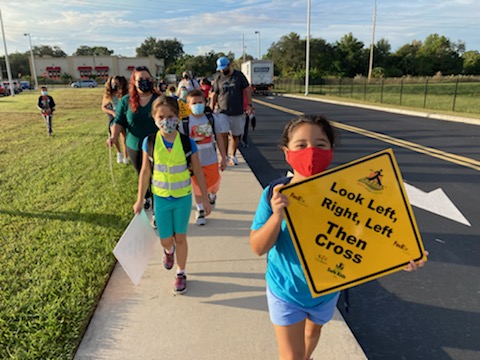
Safety is the priority for any Walk, Bike & Roll to School Day event. Follow these steps to plan for a safe event by selecting the best route and working with the community. For more information see the specific resources for pedestrian and bicycle safety below.
Including Safety in the Event
Find the safest route to school by looking for:
- Places to walk or roll that are separated from traffic. Choose sidewalks or paths wherever possible, even if that means the trip will take a little longer.
- If there are no sidewalks or paths, walk as far from motor vehicles as possible, on the side of the street facing traffic.
- Places to cross (if necessary)
- Minimize the number of street crossings.
- Avoid busy, high-speed or multi-lane roads, wherever possible.
- When available, cross at a location with an adult school crossing guard.
- Pedestrian- and bike-friendly drivers
- Look for places where drivers are paying attention, yielding to pedestrians and cyclists and respecting speed limits.
Working with a town or city transportation department
A local traffic engineer or public works official could also offer helpful input regarding complex routes.
Working with law enforcement
While law enforcement officers have been involved in many Walk & Roll to School Day and Bike & Roll to School Day events in the past, individual communities and schools need to understand their families’ preferences in having law enforcement present for an event. For some community members, negative experiences with law enforcement mean that they may not feel comfortable with any level of law enforcement involvement. For others, law enforcement involvement in Walk & Roll to School Day and Bike & Roll to School Day events can help build trust and open dialogue.
Working with the school and the community
Before the event, talk to the principal and other members of the planning team to identify potential issues and how to address them. Potential safety concerns that may be mentioned include:
- Routes that don’t have places to walk that are separated from traffic
- Routes that require crossing streets without adequate crossings
- The need for helmet use
These issues don’t have to be event-stoppers, but they will certainly influence the event’s structure. Whether the concerns are real or perceived, they should be addressed so that students, families and leaders feel comfortable. Often, events are used to prompt bigger conversations about how to address any barriers that get in the way of children walking and bicycling to school safely on a regular basis. If routes are missing sidewalks or if there’s a park that would make a great connector to a nearby neighborhood but it doesn’t feel safe, there’s a two-fold approach: 1. Make a plan for the event. 2. Use the event to bring attention to safety concerns that need to be addressed so that students can walk on a regular basis.
Pedestrian Safety
Students need to know pedestrian safety skills. Information in the resources below can be taught in the classroom or sent home with students to practice skills with their families. Ideally they get several opportunities to practice what they learn with adults who can provide feedback and supervision.
Resources:
- Tips for Parents and Other Adults for Teaching Pedestrian Safety to Children
National Center for Safe Routes to School - Sugerencias para Padres y Otros Adultos Sobre Enseñar Seguridad Peatonal a los Niños
National Center for Safe Routes to School - Helping Children Learn Pedestrian Safety Skills: Overview for parents and caregivers
National Center for Safe Routes to School - Tips for Walking Safely to School for Children
National Center for Safe Routes to School - Sugerencias para Caminar con Seguridad Hasta la Escuela por los Niños
National Center for Safe Routes to School - Pedestrian Safety Resources
National Highway Traffic Safety Administration - Pedestrian Safer Journey
Safety videos in Spanish and English for ages 5 to 18 – Federal Highway Administration - Caminar Con Cuidado
Videos de seguridad en español y en inglés para edades de 5 a 18 – Federal Highway Administration
Bike Safety
Teaching students safe biking skills is a key part of starting a bicycling program. The information in the resources below can be taught at school, or sent home with students to practice skills with their families. Ideally students get chances to hear and practice the information several times with adults who can provide feedback and supervision.
Bicycle Safety Resources
- Bicycle Safer Journey
The Federal Highway Administration - Helping Your Child Be a Safe Bicyclist
National Center for Safe Routes to School
En Español – Ayudando a su hijo a ser un ciclista seguro - Ride Your Bike Safely
National Center for Safe Routes to School
En Español – Andar en tu bicicleta con seguridad - Easy Steps to Properly Fit a Bicycle Helmet
National Highway Traffic Safety Administration - ABC Quick Check (Offers a child-oriented quick check to perform before every bike ride)
National Highway Traffic Safety Administration - Ideas to Promote Bicycle Safety
National Highway Traffic Safety Administration - Bike Safety Resources
National Highway Traffic Safety Administration - Be a Roll Model!
National Highway Traffic Safety Administration
Micromobility
Micromobility includes modes such as scooters and skateboards in addition to bicycles. For a general guide on micromobility, see this fact sheet from the Federal Highway Administration. Below are resources on other modes that students may use to get to school as well as recommendations on the use of motorized devices.
For further resources on micromobility visit the Pedestrian and Bicycle Information Center.
Original Source: https://www.walkbiketoschool.org/plan/how-to-plan/safety-first/